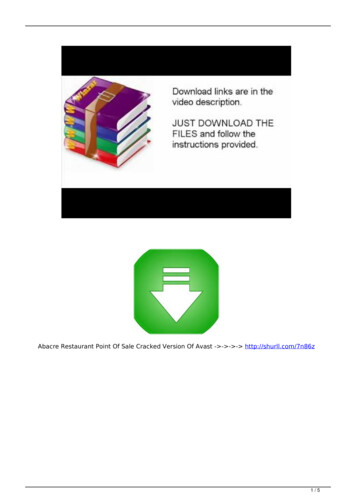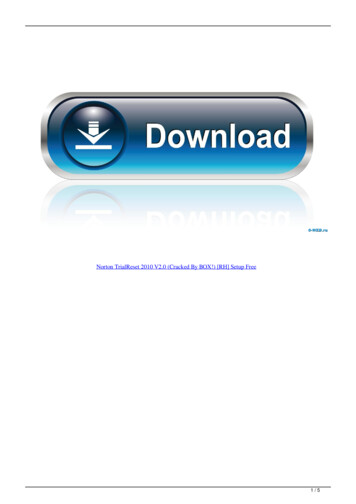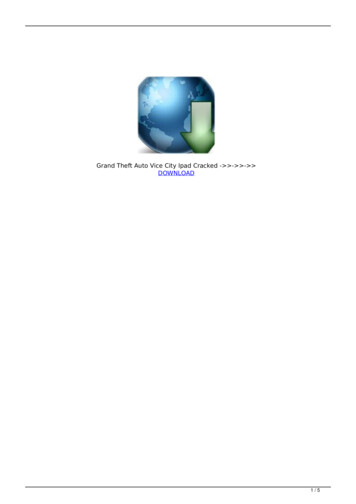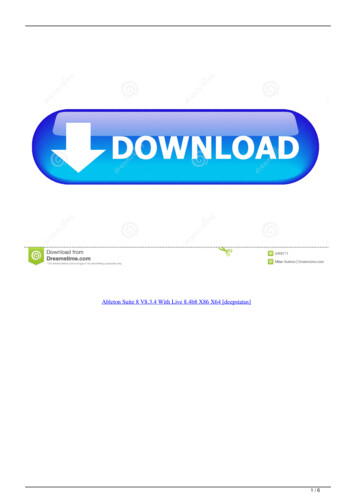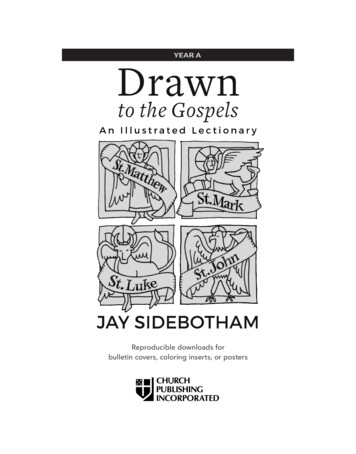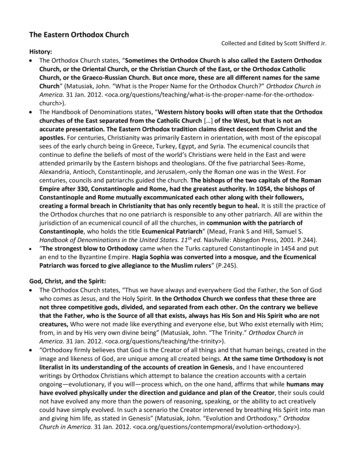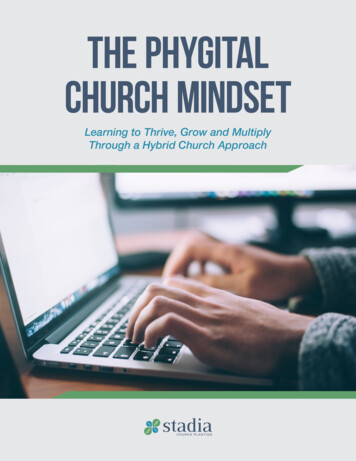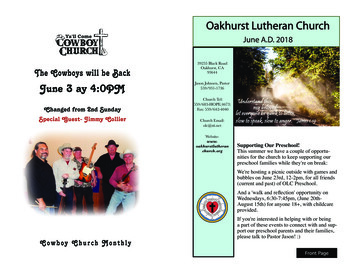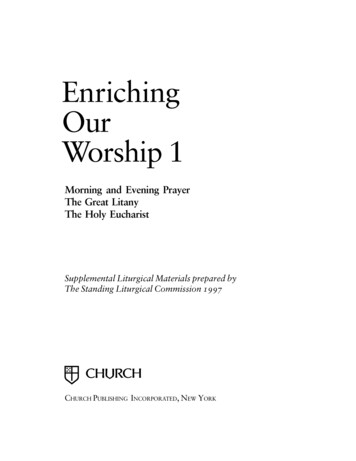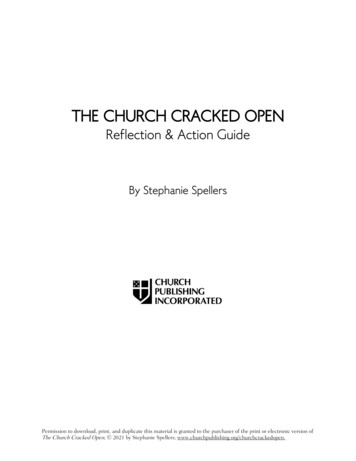
Transcription
0THE CHURCH CRACKED OPENReflection & Action GuideBy Stephanie SpellersPermission to download, print, and duplicate this material is granted to the purchaser of the print or electronic version ofThe Church Cracked Open, 2021 by Stephanie Spellers; www.churchpublishing.org/churchcrackedopen.
1THE CHURCH CRACKED OPENReflection & Action GuideA Word from the Author2Guide Contents2Ways to Engage3What?3Who?3When & How?4IntroductionOn Being Cracked Open6Chapter 1The Reality of Disruption and Decline8Chapter 2New Hope for Beloved Community14Chapter 3The Origins of the Nightmare18Chapter 4The Church of Empire24Chapter 5Shards of Light29Chapter 6Lose Your Life—Kenosis32Chapter 7Gain Your Life—Solidarity40Chapter 8Walk in Love—Discipleship45ConclusionGod Bless the Cracks53Permission to download, print, and duplicate this material is granted to the purchaser of the print or electronic version ofThe Church Cracked Open, 2021 by Stephanie Spellers; www.churchpublishing.org/churchcrackedopen.
2A Word from the AuthorWhat would it take for dominant-culture Christians to examine our lives, the lives of ourchurches, and the oppressive systems and assumptions that shape us all? Fervent prayer. Thegrace of God. Commitment. Community. In offering The Church Cracked Open, thiscompanion Reflection & Action Guide, and my website (www.churchcrackedopen.com), I hopeyou have even more help for unmasking and naming reality, revisiting the dream of what Godcreated us to be, and taking more decisive steps toward wholeness, reconciliation, justice, andlove for God, for each other, and for ourselves.Guide ContentsFor each chapter of the book, you’ll find here an accompanying set of tools for reflection andaction. Each set is organized with some combination of the following. Note: not every chapterhas a full set of Terms, Concepts, Actions, and Scriptures, so it’s alright if you don’t see one ofthese headings in the materials for a particular chapter. Entering In: A common question for stirring your initial reflections on the chapterTerms to Know: Definitions worth considering, along with reflection questions for eachConcepts to Explore: Key concepts and ideas in the chapter, along with reflectionquestions for eachActions to Take: Concrete ways to practically explore or apply material from thechapter, sometimes with charts and links to related resourcesScripture to Dwell In: Select scripture passages, cited in full from the New RevisedStandard Version (you’re warmly encouraged to explore other translations). I’ve adaptedthe Dwelling in the Word 1 process for bible study, which recommends reading a passagethree times and considering simple questions about God and God’s activity after eachreading.As you move through this guide, you will notice that I’ve provided page numbers from TheChurch Cracked Open, so you can refer easily back and forth to the print version of the book.This will also help you to track down citations, which I’ve only provided here for material notcited in the book.If you’re using an e-reader, I’ve also provided relevant text so you can search for the passagewith relative ease.Dwelling in the Word was created by Church Innovations. Learn more about the process and about the group athttp://test2.churchinnovations.org/?page id 102.1Permission to download, print, and duplicate this material is granted to the purchaser of the print or electronic version ofThe Church Cracked Open, 2021 by Stephanie Spellers; www.churchpublishing.org/churchcrackedopen.
3Ways to EngageNow that you know the guide’s content, here are some strategies for engaging the material thatfollows:What?Feel free to use as much or as little of this material as you wish. Your choice depends onyour focus or that of your group. For instance Intuitive and personal journey: You may choose to focus on the “Entering In”and “Scripture to Dwell In” sections of the guide.Relevant terms and ideas: You might reflect with the “Terms to Know” and“Concepts to Explore” sections of the guide.Practical action: It might be wise to highlight the “Actions to Take” section foreach chapter that features one.Holistic journey: You could work with the full suite of guide content for eachchapter. It will take more time, but you will engage heart and head, personal andinstitutional, societal and spiritual.Go with the Spirit: Feel free to engage whatever reflections and prompts mostresonate for you or to make up your own.And remember: Not every chapter features a full set of Terms, Concepts, Actions, andScriptures, so don’t be alarmed if you don’t see one of these section headings in thematerials for a particular chapter. There will be plenty to explore.Who? Individualo If you’re alone, feel free to pull out your journal – maybe even get a new onejust for this journey.o If you’ve completed the book, this guide is a helpful way to review some ofthe most important material, this time with help dropping deeper in yourlearning and exploration.o You can also alternate by reading a chapter and then using the guide toreflect and act as you go. Small Group/Congregationo Read the “What?” outline above and decide as a group or as a facilitationteam what strategy works best for you.o If you need help organizing a small group, managing facilitation, or dealingwith other elements of getting started and moving forward, check out theEpiscopal Church’s resource for “Building Intentional Small Groups” ding-intentional-smallgroups.Permission to download, print, and duplicate this material is granted to the purchaser of the print or electronic version ofThe Church Cracked Open, 2021 by Stephanie Spellers; www.churchpublishing.org/churchcrackedopen.
4When & How?The answer entirely depends on your schedule, group size, hopes, and expectations.Please take care to narrow your reflection focus (see “What?” above). Don’t attempt toget through all the companion material and reflection questions for each chapter ifyou’re meeting for a shorter time or with a larger group. Otherwise, you will feel rushed,and no one will have the chance to share meaningfully. It’s also worth noting one moretime: Not every chapter has a full set of Terms, Concepts, Actions, and Scriptures, sodon’t be alarmed if you don’t see one of those headings in the materials for a particularchapter.Here are a few suggestions for groups discerning the best pace for their journey: Seasonal Book Group (45 minutes - 1 hour): The Church Cracked Open is notintended to be a particularly long or dense text, so you could read it in a seasonalbook group that meets weekly for 45 minutes to 1 hour. If you go this route o Depending on the group size, you might choose two of the options under“What?”. Start with check-ins using the “Entering In” question(s). Thendiscuss “Terms to Know” or “Concepts to Explore” OR work on one of the“Actions to Take” as a group.o Ideally, you should take 10 weeks/sessions for the 10 chapters.o If you’ve got seven sessions, you may choose to double up with two chaptersin one session. Here are some suggestions for possible pairings: Introduction and Chapter 1 Chapters 2 and 3 Chapter 8 and Conclusion Monthly Book Study Group (90 minutes - 2 hours): With more time, you can buildrelationships, learn together, and move toward action.o Opening Prayer (3 minutes)o Check-ins: Begin with brief check-ins using the “Entering In” question(s) (15minutes)o Terms: Facilitator introduces each of the “Terms to Know” and invitesclarifying conversation (15-20 minutes)o Concepts: Choose a few of the “Concepts to Explore” to reflect on as a group(15-20 minutes)o Actions: Choose one of the “Actions to Take” and reflect as a group (20-25minutes). If it makes sense, invite each person to name their personalcommitment to action or practical exploration.o Scripture: Choose one “Scripture to Dwell In” (20 minutes). Share in pairsfor the first two questions, and engage as a group for the final question.o Closing Prayer (2 minutes)Permission to download, print, and duplicate this material is granted to the purchaser of the print or electronic version ofThe Church Cracked Open, 2021 by Stephanie Spellers; www.churchpublishing.org/churchcrackedopen.
5 Reflection as Part of Ongoing Group Meeting (30 minutes): If you’re in a group thatmeets regularly for another purpose (like a Vestry or other committee or leadershipteam), you could start or end your sessions by reflecting on a chapter. It only takesabout 30 minutes if you focus on only one of these options:o Option 1: Invite each person to respond briefly to the “Entering In”question(s)o Option 2: Invite each person to choose one of the “Terms to Know” or“Concepts to Explore” that grasped their attention, and reflect briefly on theaccompanying question.o Option 3: Choose one or two of the “Terms to Know,” “Concepts to Explore,”or “Actions to Take,” and invite the group to reflect with it together for thefull timeo Option 4: Engage in “Scripture to Dwell In” as a group. Share in pairs for thefirst two questions, and engage as a group for the final question.Feel free to share stories and images about how you’re engaging at #churchcrackedopen. Andstay tuned to www.churchcrackedopen.com for additional resources, conversations, andwhatever else the Spirit chooses to bring to life.Before proceeding, I have to offer special thanks for my colleagues Jerusalem Greer andMelanie Mullen, who brought the savvy, honest feedback and structural recommendations tomake this guide as user-friendly as possible. I appreciate you both!Throughout this project I’ve attempted to share hard stories and challenging questions withtenderness and hope. I have no doubt fallen short of the mark, but please trust that every pageof the book and of this guide is written with a heart filled with love and an abiding trust inGod’s amazing grace, which holds us especially when we’ve been cracked open.With great hope for what’s next,Permission to download, print, and duplicate this material is granted to the purchaser of the print or electronic version ofThe Church Cracked Open, 2021 by Stephanie Spellers; www.churchpublishing.org/churchcrackedopen.
6INTRODUCTION: On Being Cracked OpenEntering In1. Having read this chapter, what words or phrases stand out for you? How does what you’veread relate to your personal life? How does it connect to your faith and ministry?Concepts to Explore2. (pg. 1) The author speaks regularly of feeling “cracked open” or seeing institutions being“cracked open.”Reflect: Have you ever felt cracked open by life? Have you seen an institution ororganization crack open? How did it feel? What was happening? What was the result?3. (pg. 3) “Wilderness Time” is a web series about the contemporary church’s experience ofuncertainty, disruption, and wilderness wandering. Go to www.wildernesstime.org andlocate the first episode, “Welcome to the Wilderness.” In it, Dr. Michael Chan, assistantprofessor of Old Testament at Luther Seminary in St. Paul, MN, introduces biblicalwilderness narratives as lens for understanding our current experience of disruption andhope for deliverance. Watch the video or listen to the ome-to-thewilderness/id1519237916?i 1000478468255). (37 minutes)Reflect: What wilderness scripture passages and images most resonate for you?Actions to Take4. (pg. 2) In “Leading Beyond the Blizzard: Why Every Organization Is Now a Startup” (find itat f32fb278ff), Andy Crouch, Kurt Keilhacker, and Dave Blanchard warn that thecurrent time of disruption is less like a winter storm or a blizzard, and instead more like anextended winter or even an ice age. In response, they advise organizations to function likestartups rather than traditional institutions in maintenance-mode:A typical pitch deck for a business or nonprofit begins with a clear audience or set ofstakeholders with a clear need, and a fundamental vision for how that need can beaddressed in ways that enhance human flourishing. Call these the first three or fourslides of your deck. You do not have to discard these slides — they represent, we prayand believe, a calling given you by God. But the rest of your deck — the part thatdescribes the strategies, tactics, financial models, and partners you can mobilize — isfunctionally different.Permission to download, print, and duplicate this material is granted to the purchaser of the print or electronic version ofThe Church Cracked Open, 2021 by Stephanie Spellers; www.churchpublishing.org/churchcrackedopen.
7Prompt: Imagine you’re looking through the slide deck for your ministry. What slides would you keep? In other words, what’s your fundamental vision andessential calling from God, as a ministry?What slides have changed or should change? In other words, how are your strategies,tactics, financial models and partners shifting? What limits have you hit?Scripture to Dwell InRead the following passage three times. After each reading, reflect on one of the followingquestions. Note: If you’re in a group, you might reflect on the first two questions in pairs or (ifonline) by sharing brief responses in the chat; for the final question, participants might share asa group.1. What phrase or image grabs your attention?2. What do you see Jesus doing here? What do you see the woman with the alabaster jardoing here?3. What do you long to be or to do, given your encounter with Jesus and with this woman?Mark 14:3-9While he was at Bethany in the house of Simon the leper, as he sat at the table, a womancame with an alabaster jar of very costly ointment of nard, and she broke open the jar andpoured the ointment on his head. 4 But some were there who said to one another in anger,“Why was the ointment wasted in this way? 5 For this ointment could have been sold formore than three hundred denarii, and the money given to the poor.” And they scoldedher. 6 But Jesus said, “Let her alone; why do you trouble her? She has performed a goodservice for me. 7 For you always have the poor with you, and you can show kindness to themwhenever you wish; but you will not always have me. 8 She has done what she could; shehas anointed my body beforehand for its burial. 9 Truly I tell you, wherever the good news isproclaimed in the whole world, what she has done will be told in remembrance of her.”3Permission to download, print, and duplicate this material is granted to the purchaser of the print or electronic version ofThe Church Cracked Open, 2021 by Stephanie Spellers; www.churchpublishing.org/churchcrackedopen.
8CHAPTER 1: The Reality of Disruption and DeclineEntering In1. Having read this chapter, what words or phrases stand out for you? How does what you’veread relate to your personal life? How does it connect to your faith and ministry?Terms to Know2. Euro-tribal churches (pg. 13): Alan Roxburgh’s term to describe Episcopal, Presbyterian,Baptist, Methodist, Lutheran, and similar denominations/faith traditions that trace toEngland, Scotland, Ireland, and Northern Europe following the Reformations of thefifteenth and sixteenth centuries and the spread of colonial empires. (Note: OxfordDictionary defines a tribe as “a social division in a traditional society consisting of familiesor communities linked by social, economic, religious, or blood ties, with a common cultureand dialect, typically having a recognized leader.”)Reflect: Do you find Roxburgh’s term “Euro-tribal churches” in any way helpful? What doesit stir you to see differently or more clearly? Have you ever noticed these traditions acting astribes? In what ways?3. Empire (pg. 13): One country exercising power over another country, through colonialsettlement but also through military domination, political sovereignty, or indirect means ofcontrol.Reflect: What relationship do you see between empire and Christianity?4. Colonialism (pg. 14): The policy or practice of acquiring full or partial political control overanother country, occupying it with settlers, and exploiting it economically.Reflect: What relationship do you see between colonialism and Christianity?5. Racism (p. 21): A belief that race is a fundamental determinant of human traits andcapacities and that racial differences produce an inherent superiority of a particular race;also the systemic oppression of a racial group to the social, economic, and politicaladvantage of another.Reflect: How does this connect with or contradict your own understanding of racism?Permission to download, print, and duplicate this material is granted to the purchaser of the print or electronic version ofThe Church Cracked Open, 2021 by Stephanie Spellers; www.churchpublishing.org/churchcrackedopen.
96. White supremacy (pg. 21): The ideology, culture, and related systems that together assertthe superiority of White ideas, creations, actions, and humanity, thus ensuring theprosperity and dominion of White people and White cultures.Reflect: How does this relate to your own understanding of White supremacy? How wouldyou describe the relationship between White supremacy and America?7. Whiteness (pg. 22): The umbrella that covers, protects, and elevates light-skinned people(and others it chooses to welcome) while leaving non-White people vulnerable to violence,subjugation, and exploitation. Whiteness is not the same as White racial identity; people ofdifferent racial backgrounds can participate in Whiteness, and any person can resistsystems of White racial superiority and domination.Reflect: Does this make sense to you? How could someone who is not White participate inWhiteness? How could a White person resist Whiteness?Concepts to Explore8. (pg. 11) Many leaders claim that “dominant American Christianity has been displaced,pushed out of our buildings, away from our moorings, and out of the center . . . if there’sany center left at all”?Reflect: Do you agree or disagree with this observation? Why?9. (pg. 16) Churches are often torn between the desire to be welcoming and the desire tomaintain and protect the traditions they love. “When you love something—especiallysomething bound up with the sacred—it’s difficult to imagine why anybody else would notlove it, too. In that model, segregation is nearly inevitable.”Reflect: Why do you imagine this would be true? Have you ever seen a church protecting itsculture and traditions and as a result blocking relationship with groups who do not sharethat culture? What happened?10. (pgs. 19-20) So much of life has changed since the outbreak of the COVID pandemic.Reflect: During this time, what discoveries have you made about being church? Have younoticed new and perhaps preferable ways to worship, serve and form disciples?Permission to download, print, and duplicate this material is granted to the purchaser of the print or electronic version ofThe Church Cracked Open, 2021 by Stephanie Spellers; www.churchpublishing.org/churchcrackedopen.
1011. (pgs. 21-22) Since the death of George Floyd on May 25, 2020, people around the worldhave experienced an awakening around racism.Reflect: Since that tragic moment, what discoveries have you made about racism and racialidentity? What do you see differently/more clearly? What are you doing differently?Actions to Take12. The Episcopal Church every year posts statistics about church membership and attendance.For decades, the Episcopal Church and other majority White denominational groups haveexperienced a downward trend.Prompt: Look at the Episcopal Church’s “Fast Facts” for 2015-2019, which are availablehere: https://www.generalconvention.org/fast-facts). As you look at this summary, why doyou imagine fewer people are claiming membership in or attending these churches?13. The Episcopal Church also offers extensive neighborhood-based demographic stats forevery congregation in the U.S. If you are Episcopalian, you can locate your diocese and thencongregation. If you’re not, you can still hunt for relevant data by entering the Episcopalcongregation nearest you or by entering an address for the area you want to study.Prompt: Go to borhood and exploreyour congregation’s neighborhood. Take special note of the racial, socio-economic, age, andlinguistic groups around you. Compare to the racial, socio-economic, age, and linguisticmake-up of your congregation. Are there any surprises? Do you see particular challenges?Opportunities for new relationship?Scripture to Dwell InThe Lenten readings in 2020 (Lectionary Year A) painted a portrait of a wandering,wrestling, uncertain people. In other words, they sound a lot like today’s church. Chooseone of the passages below. Read it three times. After each reading, reflect on one of thesequestions. If you’re in a group, you might reflect on the first two questions in pairs or (ifonline) by sharing brief responses in the chat; for the final question, participants mightshare as a group.1. What phrase or image grabs your attention?2. What do you see God doing here? What do you see people doing here?3. What do you long to be, to do, or to see differently given what you see here of Godand God’s people?Permission to download, print, and duplicate this material is granted to the purchaser of the print or electronic version ofThe Church Cracked Open, 2021 by Stephanie Spellers; www.churchpublishing.org/churchcrackedopen.
11Third Sunday of LentExodus 17:1–7From the wilderness of Sin the whole congregation of the Israelites journeyed by stages, asthe LORD commanded. They camped at Rephidim, but there was no water for the people todrink. The people quarreled with Moses, and said, “Give us water to drink.” Moses said tothem, “Why do you quarrel with me? Why do you test the LORD?” But the people thirstedthere for water; and the people complained against Moses and said, “Why did you bring usout of Egypt, to kill us and our children and livestock with thirst?” So Moses cried out tothe LORD, “What shall I do with this people? They are almost ready to stone me.”The LORD said to Moses, “Go on ahead of the people, and take some of the elders of Israelwith you; take in your hand the staff with which you struck the Nile, and go. I will bestanding there in front of you on the rock at Horeb. Strike the rock, and water will come outof it, so that the people may drink.” Moses did so, in the sight of the elders of Israel. Hecalled the place Massah and Meribah, because the Israelites quarreled and testedthe LORD, saying, “Is the LORD among us or not?”Fourth Sunday of LentPsalm 231 The LORD is my shepherd; *I shall not be in want.2 He makes me lie down in green pastures *and leads me beside still waters.3 He revives my soul *and guides me along right pathways for his Name's sake.4 Though I walk through the valley of the shadow of death,I shall fear no evil; *for you are with me;your rod and your staff, they comfort me.5 You spread a table before me in the presence of those who trouble me; *you have anointed my head with oil,and my cup is running over.6 Surely your goodness and mercy shall follow me all the days of my life, *and I will dwell in the house of the LORD for ever.Permission to download, print, and duplicate this material is granted to the purchaser of the print or electronic version ofThe Church Cracked Open, 2021 by Stephanie Spellers; www.churchpublishing.org/churchcrackedopen.
12Fifth Sunday of LentJohn 11:17-22, 28-37When Jesus arrived, he found that Lazarus had already been in the tomb four days.Now Bethany was near Jerusalem, some two miles away, and many of the Jews hadcome to Martha and Mary to console them about their brother. When Martha heardthat Jesus was coming, she went and met him, while Mary stayed at home. Marthasaid to Jesus, “Lord, if you had been here, my brother would not have died. But evennow I know that God will give you whatever you ask of him.” When Martha had said this, she went back and called her sister Mary, and told herprivately, “The Teacher is here and is calling for you.” And when she heard it, she gotup quickly and went to him. Now Jesus had not yet come to the village, but was still atthe place where Martha had met him. The Jews who were with her in the house,consoling her, saw Mary get up quickly and go out. They followed her because theythought that she was going to the tomb to weep there. When Mary came where Jesuswas and saw him, she knelt at his feet and said to him, “Lord, if you had been here, mybrother would not have died.” When Jesus saw her weeping, and the Jews who camewith her also weeping, he was greatly disturbed in spirit and deeply moved. He said,“Where have you laid him?” They said to him, “Lord, come and see.” Jesus began toweep. So the Jews said, “See how he loved him!” But some of them said, “Could not hewho opened the eyes of the blind man have kept this man from dying?”Maundy ThursdayJohn 13:1-5, 33-35Now before the festival of the Passover, Jesus knew that his hour had come to depart fromthis world and go to the Father. Having loved his own who were in the world, he loved themto the end. The devil had already put it into the heart of Judas son of Simon Iscariot tobetray him. And during supper Jesus, knowing that the Father had given all things into hishands, and that he had come from God and was going to God, got up from the table, tookoff his outer robe, and tied a towel around himself. Then he poured water into a basin andbegan to wash the disciples' feet and to wipe them with the towel that was tied aroundhim. Little children, I am with you only a little longer. You will look for me; and as I said to theJews so now I say to you, Where I am going, you cannot come.' I give you a newcommandment, that you love one another. Just as I have loved you, you also should love oneanother. By this everyone will know that you are my disciples, if you have love for oneanother."Permission to download, print, and duplicate this material is granted to the purchaser of the print or electronic version ofThe Church Cracked Open, 2021 by Stephanie Spellers; www.churchpublishing.org/churchcrackedopen.
13Good FridayPsalm 22:1-111 My God, my God, why have you forsaken me? *and are so far from my cryand from the words of my distress?2 O my God, I cry in the daytime, but you do not answer; *by night as well, but I find no rest.3 Yet you are the Holy One, *enthroned upon the praises of Israel.4 Our forefathers put their trust in you; *they trusted, and you delivered them.5 They cried out to you and were delivered; *they trusted in you and were not put to shame.6 But as for me, I am a worm and no man, *scorned by all and despised by the people.7 All who see me laugh me to scorn; *they curl their lips and wag their heads, saying,8 "He trusted in the LORD; let him deliver him; *let him rescue him, if he delights in him."9 Yet you are he who took me out of the womb, *and kept me safe upon my mother's breast.10 I have been entrusted to you ever since I was born; *you were my God when I was still in my mother's womb.11 Be not far from me, for trouble is near, *and there is none to help.Permission to download, print, and duplicate this material is granted to the purchaser of the print or electronic version ofThe Church Cracked Open, 2021 by Stephanie Spellers; www.churchpublishing.org/churchcrackedopen.
14CHAPTER 2: New Hope for Beloved CommunityEntering In1. Having read this chapter, what words or phrases stand out for you? How does what you’veread relate to your personal life? How does it connect to your faith and ministry?Terms to Know2. Beloved community (pg. 34): A community animated by a non-clinging, self-emptying,persistent love that drives the members to pursue wholeness and kindness. In it, theindividual and the collective strive and sacrifice for the sake of the flourishing of the greaterwhole and for the end of all forms of domination and oppression that diminish the childrenof God.Beloved community (pg. 25): A community of people who help one another to grow into allthat they were created to be; where each person is as committed to the other’s flourishingand to the flourishing of the whole as they are to their own; and where the members arewilling to sacrifice their own comfort and even lives for the sake of the other and for thedream they share.Reflect: Have you ever seen beloved community or anything approaching it? What washappening? What made it possible?Concepts to Explore3. (pg. 25) Vida Scudder wrote in The Church and the Hour: “This is the hour of opportunity;this is the hour of the Church. In the last fifty years she has accomplished a greatpreparation, by her rediscovery of the purpose of Jesus. Few and hesitant, however, havebeen her attempts to realize that purpose, to strive boldly, through profound labors ofreadjustment and reconstruction, to establish the Kingdom of God, the kingdom of love, onearth . . .”Reflect: Scudder wrote these words in 1917. How do they resonate for you today?4. (pg. 27) Martin Luther King Jr. said the ultimate goal of the Civil Rights struggle wasfreedom, dignity, and justice for the oppressed and for the oppressor.Reflect: Do you agree? Should oppressed peoples be concerned about the lives of theiroppressors?Permission to download, print, and duplicate this material is granted to the purchaser of the print or electronic version ofThe Church Cracked Open, 2021 by Stephanie Spellers; www.churchpublishing.org/churchcrackedopen.
155. (pg. 29) Philosopher Josiah Royce says beloved community is only possible throughatonement: an act of spiritual sacrifice or reparation undertaken by an individual or groupfor the community as a whole. Such an act may function to shock the conscience of theopponent so much it cracks them open and makes way for God’s spirit to intercede.Reflect: Consider the witness of nonviolent resisters like Mahatma Gandhi and Civil Rightslead
It’s also worth noting one more time: Not every chapter has a full set of Terms, Concepts, Actions, and Scriptures, so don’t be alarmed if you don’t se


